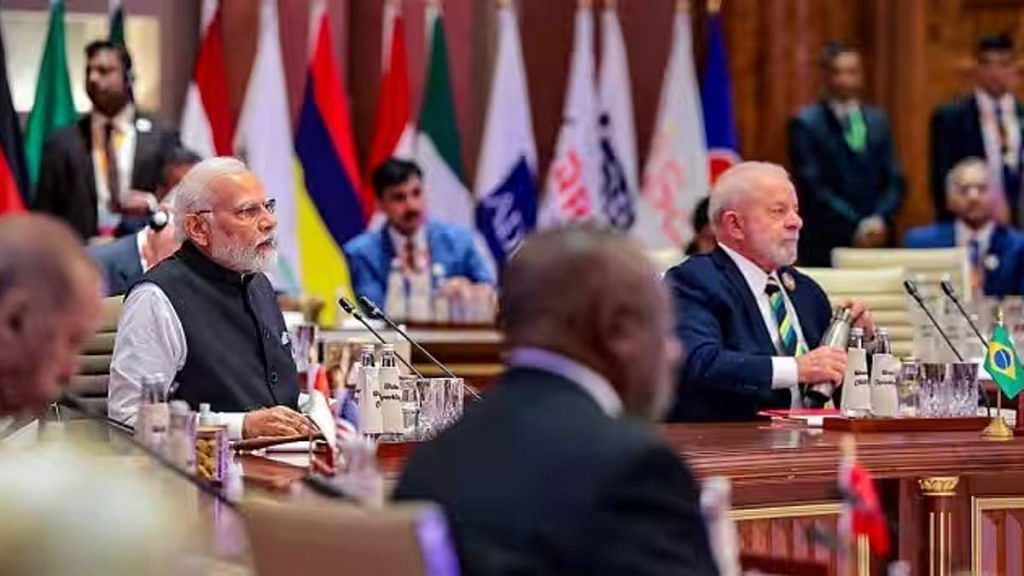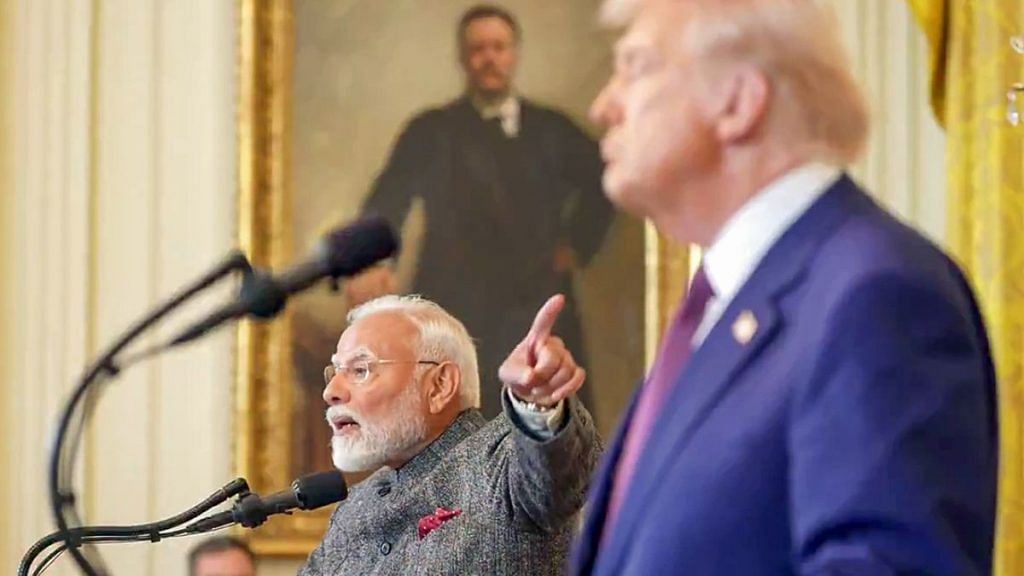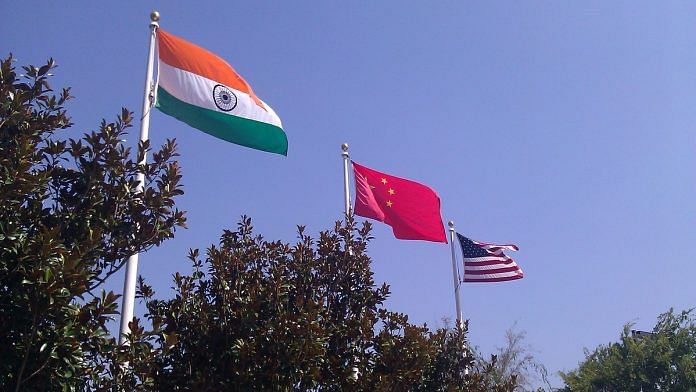India’s geopolitical context appears to have turned 180 degrees over the past few months. From being courted by all great powers just three years ago, we now find ourselves at the receiving end of strategic offensives by the China-Pakistan nexus, as well as economic arm-twisting by both China and the United States.
We took pride in being able to sit at both the Shanghai Cooperation Organization and the Quad, and in enhancing strategic ties with the US while retaining our historic relationship with Russia. The purchase of Russian oil in the wake of the Russia-Ukraine war was itself seen as testimony to Indian diplomatic dexterity, as well as evidence of our great power status. It seemed we could juggle multiple balls in the air without losing our balance.
However, in recent months, the balls appear to be falling. Trump’s scathing complaints of India’s energy and military ties with Russia (along with sanctions) are notable; and so is China’s growing disregard for Indian concerns over a wide range of issues, strategic and economic. The great powers are now crafting strong ties with a bankrupt Pakistan, with less regard for Delhi’s sensitivities than has been the norm in recent decades.
What explains this? Is this pure randomness, chance, and bad luck? Is this just Trump being Trump? Is this related to India’s foreign policy mistakes? Is this simply geopolitical shifts that are outside India’s control?
I would argue that the right answer is all of the above. But there is still a story and a common underlying thread behind this systemic downturn, and it centres on the concept and reality of the ‘sweet spot’. India appears to have gone from occupying a near-perfect geopolitical sweet spot to now inhabiting a geopolitical no-good-option deadlock. It is salient that we understand how this has come about before we consider navigation strategies.
Also Read: India is showing signs of trusting China again. Beijing sees a window of weakness
Sweet and sour spots in history
Sweet spots are a key concept in geopolitics, as several historical examples illustrate.
The US, owing to its geographic location, occupied a sweet spot since the 19th century. Its rise posed no territorial threat to any of the great powers (because it was already territorially secure), and its landmass remained immune to invasion threats. From this perch, the US enjoyed a highly exalted position—beyond its material strengths—in determining events across Eurasia since 1917. Hence, the US was appeased and courted (at great expense) by the reigning superpower, the British Empire, not because it was materially strong, but because London assessed that it would become an increasingly influential power in Europe, and one with whom its interests aligned.
In contrast, Germany had always represented the opposite: a sour spot. Placed at the centre of Europe and surrounded by great powers, German power could only grow at the expense of others—what historians term ‘the German problem’. This meant that for every division the Germans financed, their rivals (mainly France and Russia) would put forth two divisions of their own and form alliances to co-produce deterrence.
The Soviet Union in the late 1930s, under Stalin, sought to create a sweet spot not on the basis of geography (which was disadvantageous) but shrewd diplomacy. By refusing to enter into a security pact with Britain and France in the late 1930s, Stalin sought to enhance his bargaining power vis-à-vis both Nazi Germany and the West—creating what Henry Kissinger terms ‘Stalin’s Bazaar’. This strategy worked when Germany directed its expansion westward instead of toward Russia, but failed when France capitulated without weakening Germany.
India’s first sweet spot
India has occupied and lost its own sweet spot on a few occasions since 1945. Its first tryst with its sweet spot occurred prior to its tryst with destiny (independence), as is laid bare in Nehru’s instructions to the first ever diplomatic delegation to the UN in 1946. Nehru advised the team to avoid too close an alignment with both camps (West vs Soviet), so as to increase India’s bargaining position. The balancing game was not entirely successful, as India did manage to create a pro-Soviet impression in Washington, thereby heightening Pakistan’s value by the early 1950s.
In formulating India’s ‘expedient’ and ‘right’ approach to geopolitical faultlines, Nehru only mildly exaggerated India’s own global importance as a future ‘great power’ and one that was destined to lead the ‘third world’ and shape events from the Suez to South East Asia (India’s present conception of the Indo-Pacific). Hence, India’s importance took shape as both Washington and Moscow sought to enlist Delhi toward their own global positions, anticipating India’s rise and heft. This allowed India to punch above its weight in global matters, bearing the signs of an emerging great power. The consolidation of Communist China in the 1950s, meanwhile, both accentuated as well as tested this sweet spot that lasted until the mid-1960s (even as it was damaged in 1954 when US-Pakistan strategic alignment occurred, and bruised in 1962).
If India’s first sweet spot occurred in the backdrop of the emerging American–Soviet Cold War, then the contemporary sweet spot has been a function of the US-China great power competition, and in not too dissimilar a fashion.
A new peak, with conditions attached
India’s present sweet spot emerged when the US started courting it as a potential democratic counterweight to China’s rise and a future strategic ally since 2000-2001. This was triggered by India’s nuclear test of 1998 and acknowledgment of the success of the economic reforms.
In other words, the US placed a bet on India’s rise, justifying an appeasement policy that entailed short-term costs in exchange for long-term dividends. If India was to be the next China, then Washington needed to invest in developing strategic ties with Delhi for the sake of the future balance of power in Asia. China, in turn, noticed and took this bet seriously—something that India wanted and valued. In between, the two wrangled for Delhi’s affections, cooperation, and trust (with different ends in mind).
This story peaked, in many senses, from 2004 to 2019—a 15-year period that saw closer India-US ties, the civil nuclear arrangement, the rise of the Indo-Pacific and the Quad, India’s inclusion in the SCO, as well as a global consensus that India was fast emerging as an influential geopolitical power in Asia and in international politics. Hence, despite occupying a geography sandwiched between nuclear and revisionist adversaries, India somehow ascended into sweet spot territory. Meanwhile, as a bonus, Russia also displayed an interest in nurturing strategic ties with India, keeping China in mind—and thus supported India’s SCO membership.
This sweet spot reflected India’s exalted bargaining position with each major power, since it had not yet ‘aligned’ or made a firm strategic choice, even as it leaned slightly towards the West. However, this dynamic was never cast in stone. It was always contingent on a few factors, mainly:
- A relatively peaceful and benign geopolitical environment, where long-term dividends were valued more than short-term gains, and where ‘bets’ were still untested
- A belief that India could make an alignment (not necessarily alliance) choice based on a reasoned assessment of its own interests—making the chase worthwhile
- A belief that India’s rise was inexorable and notionally comparable (not equal) to China in terms of economic and military wherewithal
- A belief (on China’s part) that India-US strategic alignment (deterrence co-production) was a real possibility, and an outcome that had to be prevented
Since 2020, all four of the above conditions have been weakened, leading to a much-changed geopolitical context for India. Let’s go through the reasons very briefly.
Firstly, the global environment has changed drastically in recent years, marked by wars and crises in multiple regions, as well as by China’s quickening sprint toward becoming a great power. This has made historically friendlier powers such as Russia and the US prioritise short-term gains (through leverages) over long-term bets that are low on immediate rewards.
Secondly, India’s own fierce (and justifiable) assertions of strategic autonomy in the wake of the Russia-Ukraine war signalled to Washington that its bet may have been based on overly optimistic assumptions. This has led to a new realism in Washington, shifting the framework toward greater transactionalism.
Thirdly, there is growing scepticism about India’s technology, manufacturing, and military trajectories. This has meant that expectations of benefitting from India’s rising international weight have been delayed—logically implying that the need to cultivate India can also wait for a while.
Fourth, China’s aggressive actions at the LAC in 2020 and beyond have cast doubt in both Delhi and Washington over the medium-term strategic utility of the India-US partnership. The US was not in a position to alter the strategic balance in the Himalayas (especially from Delhi’s point of view), while India’s impasse raised doubts over whether it could realistically emerge as a net security provider in the region vis-à-vis China when the threat from the latter appeared to loom so large over the subcontinent.
Russia-Ukraine war as catalyst
As the structural basis of India’s sweet spot came under stress, the Russia-Ukraine war erupted and became the central fulcrum of geopolitics in 2022-2024, and arguably remains so. As the Biden administration sought to rally its allies, partners, and dependents, it naturally looked to India to play a ‘productive’ role in ending the conflict, either by persuading Moscow to change course or by condemning Russian actions.
Both avenues rested on intense over-estimations of India’s role and capabilities.
The idea that India could persuade Moscow assumed that Delhi had significant leverage in the Kremlin. Meanwhile, expectations of condemnation assumed that India still retained an international moral voice and aura that could tilt the scales. Both views, to be frank, rested on romantic notions of India’s role and value in the world.
India, in turn, did not necessarily resist this romantic lens, as it heightened estimations of India’s ‘power’—even as Delhi rejected the specific policy expectations that came with it. This intensified India’s ‘sweet spot’, especially in 2023, when it hosted the G20. But due to structural factors, it came with a built-in expiry date, mostly unbeknownst to India at the time.

For a while, though, this over-expectation led to an intense courting of India, likely with hopes of getting it to ‘do something’. This included iCET, a bilateral initiative to boost cooperation in advanced technologies, announced in 2022. It may be inferred that Washington hoped opening US military and tech doors to India would be enough to persuade Delhi to downgrade its relationship with Moscow.
By 2024, however, it appeared to the US that its efforts had run aground and a new ‘realism’ started to strengthen in Washington. This new thinking suggested that India had always been committed to multi-alignment, and was not destined to develop greater strategic ties with the US. This signalled that the bet had always rested on shaky grounds, which the Russia-Ukraine war only laid bare.
With the US bet souring, the other side of the ledger had to be affected as well. If China’s restraint towards India was in part driven by the need to prevent a US-India strategic alignment, then the dimming prospect of the latter compromised India’s leverage vis-à-vis China.
Meanwhile, growing military, diplomatic, and economic asymmetries appear to have persuaded Beijing that relations between the two Asian powers should be placed on a hierarchical footing, rather than on the three mutuals suggested by India, and that China’s security interests vis-à-vis India are best served through the exercise of hard leverage rather than soft appeasement.
China’s strategic pressure on India has the effect of weakening Delhi’s bargaining position with the US, while Washington’s reassessment of ties would have further enhanced Beijing’s confidence vis-à-vis India—creating a self-feeding spiral.
Also Read: India’s response to Trump is an emotional one. Tariff damage is psychological
What comes after the sweet spot?
India now finds itself navigating geopolitical realities without the aid of its famed sweet spot. This marks a radical shift that undoes many of Delhi’s core foreign policy axioms. For the first time in decades, Delhi is facing a fracturing world in which the great powers are displaying little interest in ‘cultivating’ India. Instead, they show greater interest in short-term, hard-nosed approaches that verge on strategic arm-twisting.
This is not merely a short-term reversal in fortunes but is likely to be the pre-dominant zeitgeist, in varying shades, for the next decade or more. As Pakistan and China move toward deeper military cooperation, India will struggle to rely on external friends and partners to offset the trend. Its underdeveloped defence-industrial base will find it difficult to keep pace with Pakistan’s rapid induction of tanks, jets, artillery, drones, and ships—unless changes are made.

India-US ties will eventually repair the ongoing damage to bilateral relations, but they won’t resemble the ‘golden days’ of the strategic partnership from 2000-2020/21. Despite India’s resistance to Western pressure on Russia, Moscow has displayed no real inclination to ‘reciprocate’ and take India’s side when it comes to the China-Pakistan challenge. If anything, Moscow’s ties with both have steadily improved over the past decade. Russia now seems to believe that those relationships (along with India’s military dependency on Russian systems) are useful ways of exerting influence on India’s Russia policy.
The loss of the sweet spot is largely irreversible at this point. Tactically courting China to change US strategic policy toward India, and vice versa, is unlikely to bear fruit from this point on. The US is unlikely to be overly concerned about an India-China axis. And China has no reason to think that a closer and meaningful India-US strategic partnership is likely.
Hence, India’s bilateral relations with each will have to increasingly rely on other levers and on real capacity-building at home, rather than generating dividends via positioning, threats, and inducements. India’s foreign policy context is not likely to ever return to a period as good as the first two decades of this century. Its primary challenge would lie in minimising the harm that is coming its way.
This requires strong shifts in existing policy trajectory and grand strategy—from one based on exuberance to one based on true realism; from one based on the pursuit of power and status, to one based on the pursuit of core security and economic interests.
Sidharth Raimedhi is a Fellow at the Council for Strategic and Defense Research (CSDR), a New Delhi-based think tank. He tweets @SidharthRaimed1. Views are personal.
(Edited by Asavari Singh)





Excellent if sobering analysis….between a rock and a hard place for now, if Mr.Raimedhi is right.
Socialism, farming, and diary are responsible for the sorry state of affairs.
Thoughtful column. The obsession with gaining a permanent seat on the Security Council. 2. At the core of Indian foreign policy should lie two major objectives. Aiding the rapid economic transformation of the sort China has achieved. An approach to the fused China – Pakistan threat which lowers the risk of war to very much lower than where it stands today, avoiding a costly arms race, to making us overly dependent on others who will exact a price.